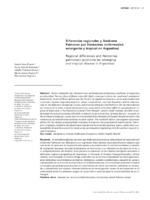Please use this identifier to cite or link to this item:
http://sgc.anlis.gob.ar/handle/123456789/260| DC Field | Value | Language |
|---|---|---|
| dc.contributor.author | Sosa-Estani, Sergio | - |
| dc.contributor.author | Salomón, Oscar Daniel | - |
| dc.contributor.author | Gómez, Adolfo | - |
| dc.contributor.author | Esquivel, María Laura | - |
| dc.contributor.author | Segura, Elsa L. | - |
| dc.date.accessioned | 2012-10-23T16:30:18Z | - |
| dc.date.available | 2012-10-23T16:30:18Z | - |
| dc.date.issued | 2001 | - |
| dc.identifier.issn | 1678-4464 | - |
| dc.identifier.uri | http://sgc.anlis.gob.ar/handle/123456789/260 | - |
| dc.identifier.uri | http://www.scielo.br/pdf/csp/v17s0/3880.pdf | - |
| dc.description | Factors related to the characteristics of Hantavirus pulmonary syndrome in Argentina are described. Factors from different scientific fields converge to form the syndrome’s analytical framework. Some of these factors are the history of spatial occupation, work and production structures, human migration patterns, ethnic composition, reservoir dynamics and its relationship to the different circulating viruses, and human behavior. Furthermore, the multiple factors are expressed in three ecological frameworks, associated with three different geographical regions of Argentina: 1) Northwest; 2) Central (“wet Pampa”); and 3) South Andean. In order to understand the actual causality of health or disease as an interaction of many factors, research on the primary biological, social, and environmental determinants of diseases should attend to the complexity of variable relationships in each region. The multiple-factor convergence approach allows for the design of appropriate strategies to improve the population’s health status. Therefore, strategies should be developed and transferred by multidisciplinary teams, while their sustainability should be assured by community participation beginning with the earliest steps of research onward. | en_US |
| dc.description | Se describen algunos factores que habrían favorecido a caracterizar la expresión del Síndrome Pulmonar por Hantavirus en Argentina. Estos factores muestran diversos orígenes que van desde los procesos de ocupación del espacio y de producción, la estructura laboral, el patrón de migración humana, la etnia, la dinámica de reservorios y su relación con los tipos de virus, y el comportamiento del hombre. Estos factores se expresan en tres marcos ecológicos asociados a diferentes regiones geográficas de Argentina: 1) Noroeste, 2) Central (Pampa húmeda) y 3) Sur Andina. Este complejo escenario obliga a abordar con la misma complejidad las investigaciones, para identificar determinantes primarios, biológicos, sociales y ambientales, causales de salud o enfermedad en su estrecha interacción y no individualmente. Este abordaje permitirá diseñar estrategias apropiadas para mejorar las condiciones de salud. Las mismas deberían ser diseñadas y transferidas por equipos transdisciplinarios de investigación, donde la participación de la comunidad desde las primeras etapas de desarrollo es esencial para la sustentabilidad de la estrategia. | en_US |
| dc.description | Fil: Sosa-Estani, Sergio. ANLIS Dr.C.G.Malbrán. Centro Nacional de Diagnóstico e Investigación en Endemo-Epidemias; Argentina. | en_US |
| dc.description | Fil: Salomón, Oscar Daniel. ANLIS Dr.C.G.Malbrán. Centro Nacional de Diagnóstico e Investigación en Endemo-Epidemias; Argentina. | en_US |
| dc.description | Fil: Gómez, Adolfo. ANLIS Dr.C.G.Malbrán. Centro Nacional de Diagnóstico e Investigación en Endemo-Epidemias; Argentina. | en_US |
| dc.description | Fil: Esquivel, María Laura. ANLIS Dr.C.G.Malbrán. Centro Nacional de Diagnóstico e Investigación en Endemo-Epidemias; Argentina. | en_US |
| dc.description | Fil: Segura, Elsa Leonor.ANLIS Dr.C.G.Malbrán; Argentina. | en_US |
| dc.format | application/pdf | ES |
| dc.language.iso | spa | en_US |
| dc.rights | info:eu-repo/semantics/openAccess | en_US |
| dc.source | Cadernos De Saúde Pública, 2001, 17 Suppl, 47–57. | en_US |
| dc.subject | Hantavirus | en_US |
| dc.subject | Brotes de Enfermedades | en_US |
| dc.subject | Síndrome Pulmonar por Hantavirus | en_US |
| dc.subject | Ecosistema | en_US |
| dc.subject | Salud Pública | en_US |
| dc.subject | Argentina | en_US |
| dc.title | Diferencias regionales y Síndrome Pulmonar por Hantavirus (enfermedad emergente y tropical en Argentina) | en_US |
| dc.title.alternative | Regional differences and Hantavirus pulmonary syndrome (an emerging and tropical disease in Argentina) | en_US |
| dc.type | Artículo | es |
| dc.coverage | ARG | en_US |
| anlis.essnrd | 1 | es |
| item.openairetype | Artículo | - |
| item.openairecristype | http://purl.org/coar/resource_type/c_18cf | - |
| item.grantfulltext | open | - |
| item.languageiso639-1 | es | - |
| item.fulltext | With Fulltext | - |
| item.cerifentitytype | Publications | - |
| crisitem.author.dept | Administración Nacional de Laboratorios e Institutos de Salud “Dr. Carlos G. Malbrán” (ANLIS) | - |
| crisitem.author.dept | Administración Nacional de Laboratorios e Institutos de Salud “Dr. Carlos G. Malbrán” (ANLIS) | - |
| crisitem.author.dept | Instituto Nacional de Medicina Tropical (INMeT) | - |
| crisitem.author.dept | Administración Nacional de Laboratorios e Institutos de Salud “Dr. Carlos G. Malbrán” (ANLIS) | - |
| crisitem.author.dept | Instituto Nacional de Parasitología (INP) | - |
| crisitem.author.parentorg | Administración Nacional de Laboratorios e Institutos de Salud “Dr. Carlos G. Malbrán” (ANLIS) | - |
| crisitem.author.parentorg | Administración Nacional de Laboratorios e Institutos de Salud “Dr. Carlos G. Malbrán” (ANLIS) | - |
| Appears in Collections: | Publicaciones snrd snrd Publicaciones CeNDIE | |
Files in This Item:
| File | Description | Size | Format | |
|---|---|---|---|---|
| CadernosDeSaúdePública,2001,17Suppl,47–57..pdf | 374.54 kB | Adobe PDF |  View/Open |
Page view(s)
173
checked on Dec 17, 2025
Download(s)
96
checked on Dec 17, 2025
Google ScholarTM
Check
Items in DSpace are protected by copyright, with all rights reserved, unless otherwise indicated.

